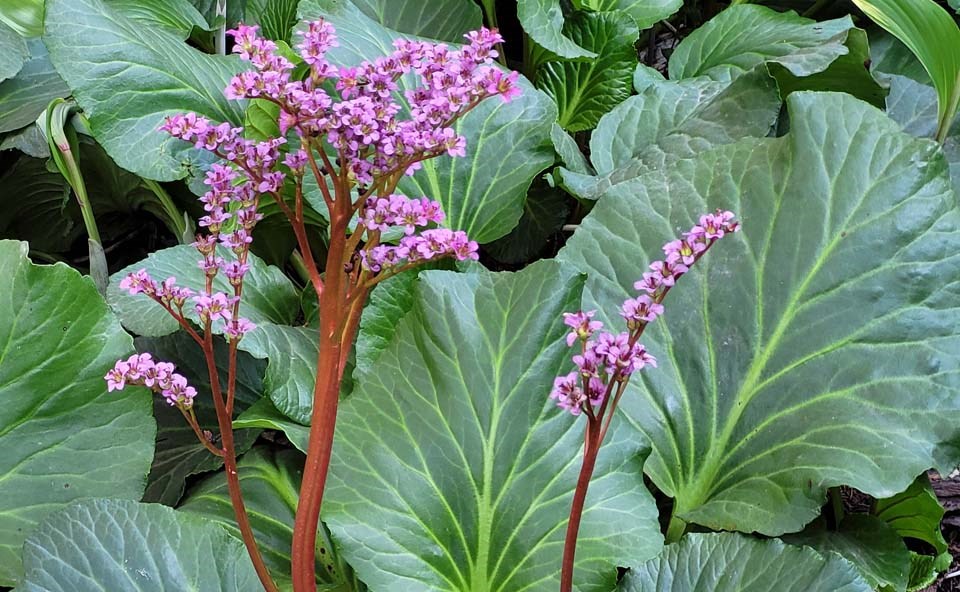Why not go for perennials with large leaves and let their foliage make a statement? Flowers may be fleeting, but the foliage is there for the entire growing season. If you have the space, go for it. Here are some perennials you might consider.
Bergenia (Bergenia cordifolia) has large, handsome leaves that turn a reddish bronze in the fall. Clusters of rosy-pink flowers are produced in early spring. Native to Siberia, it’s very adaptable and will grow in sun or shade. It’s a useful plant for rock gardens, the edge of a pond, edging, or the front of a perennial border. Easily propagated by division.
Marsh marigold (Caltha palustris) is native to the wetlands of Canada as well as Europe. It needs a moist or wet habitat, so try to duplicate its natural habitat. Yellow, buttercup-like flowers are produced in early spring above large, heart-shaped leaves. Grow in full sun or partial shade with even moisture. It’s ideal for ponds, streams or water gardens. Propagate by division.
Goatsbeard (Aruncus dioicus) is a tall perennial, up to 1.3 m (4 ft.) with an equal spread, producing panicles of cream white flowers in June and July above large, compound, feathery dark green leaves. Male and female flowers are on separate plants, with the male plants considerably more showy. The leaves turn bronze in fall. It is best grown in partial shade with even moisture. Best placed toward the back of a border, it is easily propagated by division.
Hosta ‘Sum and Substance’ is one of the largest hostas available, with leaves of up to 16 inches, forming a huge mound. Leaf colour varies from light green to chartreuse to gold, depending on the sunlight available. It will grow in full sun to partial shade but needs even moisture.
Ligularia (Ligularia dentata) is a tall perennial (90 to 120 cm/3 to 4 ft) with huge, rounded or kidney-shaped basal leaves. Spikes of yellow to orange flowers are produced in July or August. Give them even moisture and a deep soil that has been enriched with organic matter. They will do better in full to partial shade. They are long-lived and non-invasive.
Lungwort (Pulmonaria spp.) were once thought to cure lung problems, thus the common name. In the 1400s, it was believed that a plant’s physical appearance indicated its medicinal use. Thus, the large spotted leaves were compared to diseased lungs. Long-lived and non-invasive, they prefer an evenly moist soil in full or partial shade. Flowers vary from blue to pink in spring.
Joe Pye Weed (Eutrochium maculatum) is native to North America, including Ontario. It is a bold, architectural plant with good foliage, a height of 150-250 cm and a spread of 90-120 cm. It will grow in full sun to partial shade in evenly moist soil. It has purple flowers in fall.
Delphinium (Delphinium elatum) is an old-fashioned plant well adapted to prairie conditions. Up to 120 to 180 cm in height, they have attractive palmate leaves and flowers in white, blue or pink. They do best in full sun with adequate moisture and good fertility and are best placed toward the back of a border.
Rhubarb (Rheum hybridum) is better known for its edible stalks, but the triangular leaves are enormous (but toxic, containing high levels of oxalic acid and anthrone glycosides)! The stalks are widely used in pies, muffins, cakes and other goodies.
Shieldleaf rodgersia (Astilboides tabularis) has huge, rounded leaves up to 90 cm across and astilbe-like white flowers in June and July. Native to northern China, they do best in moist soils in partial to full shade.
Astilbe (Astilbe chinensis ‘Pumila’) was introduced from China in 1892. Noted for their large, finely divided leaves, they spread by stolons to form dense, compact clumps. Only 30 cm high, they produce fluffy pink flowers in late July, early August. They do best in partial shade in evenly moist organic soil.
This column is provided courtesy of the Saskatchewan Perennial Society
(SPS; [email protected]). Check our website () or Facebook page () for a list of upcoming gardening events.




